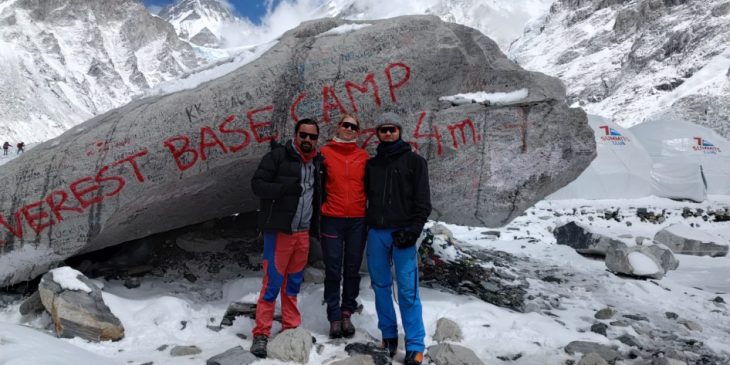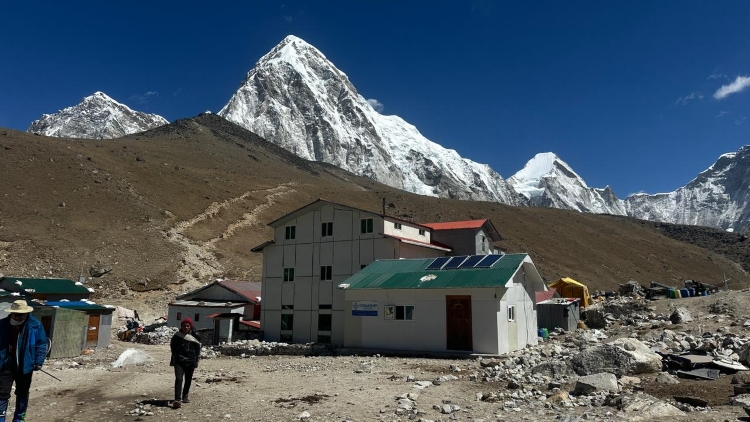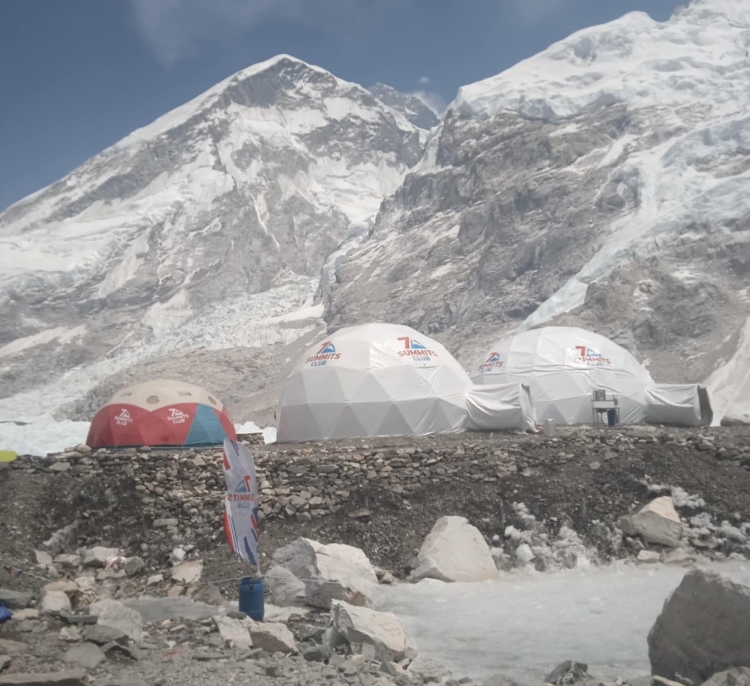
Trekking to Everest Base Camp is a legendary adventure that draws thousands of hikers from around the world each year. This iconic journey through the Nepalese Himalayas offers breathtaking views, rich cultural experiences, and the thrill of walking in the footsteps of mountaineering legends. For many, reaching Everest Base Camp represents the pinnacle of trekking achievements, combining physical challenge with awe-inspiring natural beauty. Trekking to Everest Base Camp 2025-2026 is expected to be more rewarding than ever. Whether you are an experienced trekker or, passionate adventurer, the everest base camp trek remains a bucket list experience
This Everest Base Camp trek guide aims to equip trekkers with essential information to plan and execute a successful Trekking to Everest Base Camp. It covers crucial aspects such as the best times to go, necessary gear and preparations, the route from Lukla airport through picturesque villages and teahouses, and strategies to deal with altitude sickness. By following this guide, hikers can maximize their chances of a safe and rewarding journey to the base of the world’s highest mountain.
Table of Contents
Trekking to Everest Base Camp 2025-2026: When to Go and What to Bring
Best Seasons for Trekking to EBC
The Everest Base Camp (EBC) trek offers distinct experiences across different seasons. Trekkers should carefully consider the timing of their adventure to ensure optimal conditions and enjoyment.
Pre-monsoon season, spanning from February to May, presents stable and dry weather, ideal for trekking. Late February and early March stand out as particularly favorable times, offering clear skies, crisp air, and spectacular views. However, trekkers should be prepared for freezing temperatures during this period.
Post-monsoon season, from late September to November, is characterized by clearer skies and less haze, providing better mountain views. October is notably the most popular month for the EBC trek, boasting stable weather and moderate temperatures. November brings fantastic trekking conditions with clear skies and cooler evenings.
Winter months (December to February) offer a unique experience with fewer crowds, but temperatures can plummet to -30°C at night. Proper equipment and preparation are crucial for winter treks.
The monsoon season (June to September) brings warmer temperatures but also heavy rainfall, making trails muddy and trekking conditions challenging. It’s generally advisable to avoid this period unless necessary.
Essential Gears and Equipment
Proper gear is crucial for a successful and comfortable EBC trek. Trekkers should prioritize high-quality, warm clothing and essential equipment.
Key items to pack include:
- Waterproof and down jackets
- Waterproof trousers and lightweight trekking pants
- Thermal layers (top and bottom, preferably merino wool)
- Trekking shirts and fleece mid-layers
- Waterproof gloves and glove liners
- Hiking socks (multiple pairs)
- Wool hat and sun hat
- Sunglasses and buff
- Well-worn, waterproof hiking boots
- Lightweight trainers for evenings
For sleeping comfort, a four-season sleeping bag with a liner is essential. Don’t forget a headtorch for navigating in low light conditions.
Other crucial items include:
- Trekking poles
- Water bottles (two 1-liter bottles)
- Water purification system
- Day pack with rain cover (30+ liters)
- Rucksack or duffel bag (around 65 liters) for porters
It’s important to note the baggage allowance for the flight to Lukla: 15 kilograms combined for checked bag and carry-on.
Physical Preparation and Training
Adequate physical conditioning is vital for an enjoyable and safe Everest Base Camp trek. Trekkers should begin their preparation 3 to 6 months before the trek.
Key aspects of training include:
- Cardio endurance: Focus on activities like walking, jogging, swimming, or cycling to improve oxygen efficiency.
- Strength endurance: Incorporate full-body strength workouts twice a week.
- Hiking practice: Aim for long walks or hikes at least once a week, building up to 5-6 hour durations with minimal breaks.
- Elevation training: If possible, practice hiking on hills or mountains. Alternatively, use a treadmill with incline or a stair stepper.
- Backpack training: Get used to carrying a daypack during practice hikes, gradually increasing the weight.
Trekkers should also focus on breaking in their hiking boots well before the trek to ensure comfort and prevent blisters. It’s advisable to start training at least 8-12 weeks before the trek, allowing the body ample time to adjust.
Remember, the trekking to Everest Base Camp is not a race but a test of endurance. Proper preparation will significantly enhance the trekking experience and help manage the challenges of high altitude and demanding terrain.
The Journey to Everest Base Camp

Kathmandu Lukla Flight
The journey to Everest Base Camp typically begins with a thrilling flight from Kathmandu to Lukla. This short 30 minute flight offers breathtaking views of the Himalayan mountain ranges and isolated valleys below. Lukla’s Tenzing-Hillary Airport, situated at an elevation of 9,400 feet (2,860 m), serves as the primary gateway for trekkers and climbers heading to the Everest region.
While the Lukla airport has gained a reputation as one of the world’s most dangerous airports, it’s important to note that safety measures have significantly improved since 2008. The airport handles approximately 20 to 30 aircraft landings daily during peak season, accommodating nearly 30,000 annual visitors to the area.
Trekkers should be prepared for potential flight delays, especially during the monsoon season from late May to early September. Weather conditions can change rapidly, and airlines prioritize passenger safety, often rescheduling or canceling flights when necessary.
Key Stops and Acclimatization
The trek from Lukla to Everest Base Camp involves several key stops and acclimatization points. Here’s an overview of the journey:
- Lukla to Phakding: The trek begins with a 2-3 hour walk from Lukla to Phakding, following a gentle uphill path alongside terrace farms.
- Namche Bazaar: This famous Sherpa town serves as a crucial acclimatization point. Trekkers typically spend three nights here at an altitude of 3,440m (11,286 feet) to adjust to the increasing elevation.
- Tengboche: After Namche, the trail descends through Trashinga before a steep climb through dense forest to reach Tengboche. This leg of the journey offers stunning views of the Everest mountain range.
- Dingboche: Located at 4,400 meters (14,435 feet), Dingboche is another important acclimatization stop. Trekkers often spend two nights here, including a day hike to Chukhung Ri for better altitude adaptation.
- Lobuche: The trek from Dingboche to Lobuche involves crossing glacial moraines and navigating challenging terrain.
Trekking to EBC and Kalapatthar
The final stretch to Everest Base Camp (EBC) and Kala Patthar is both challenging and rewarding:
- Gorak Shep: This is the last settlement before EBC, serving as a base for the final push to the camp and the ascent of Kala Patar.
- Everest Base Camp: The trek from Gorak Shep to EBC takes about 2-3 hours, depending on altitude effects. Trekkers navigate over the Khumbu Glacier to reach the iconic base camp.
- Kala Patthar: Often considered the highlight of the trek, Kala Patar offers unparalleled views of Mount Everest. The climb to this 5,545-meter (18,192 feet) viewpoint typically starts early in the morning, taking 1-2 hours from Gorak Shep.
Throughout the journey, proper acclimatization is crucial for a safe and enjoyable experience. The trek incorporates strategic rest days and gradual ascents to help trekkers adjust to the increasing altitude. Staying hydrated, maintaining a steady pace, and listening to your body are essential practices for a successful trek to Everest Base Camp
Outline Itinerary for Trekking to EBC
| Day | Itinerary | Elevation (M) | Trek hour |
| 1 | Arrival in Kathmandu | 1300 M | |
| 2 | Fly from Kathmandu to Lukla and Trek to Phakding (30 min flight) | 2651m | 2-3 hrs |
| 3 | Trek from Phakding to Namche Bazaar | 3440m | 5-6 hrs |
| 4 | Side trip and rest day in Namche Bazaar | 3440m | 3-4 hrs |
| 5 | Trek from Namche Bazaar to Tengboche | 3860m | 5-6 hrs |
| 6 | Trek from Tengboche to Dingboche | 4343m | 5-6 hrs |
| 7 | Acclimatization Day – Dingboche | 4343m | 3-4 hrs |
| 8 | Trek from Dingboche to Lobuche | 4950m | 5-6 hrs |
| 9 | Trek from Lobuche to Everest Base Camp, then back to Gorak Shep | 5370m | 6-7 hrs |
| 10 | Morning hike up to Kala Patthar(5643M) and trek from Gorak Shep to Pheriche | 4371m | 7-8 hrs |
| 11 | Trek from Pheriche to Namche Bazaar | 3440m | 6-7 hrs |
| 12 | Trek from Namche Bazaar to Lukla | 2800m | 6-7 hrs |
| 13 | Fly back from Kathmandu to Lukla | 1300m | 30 min |
| 14 | Final Departure |
Dealing With High Altitude and Staying Healthy
Symptoms of Altitude Sickness
Altitude sickness, also known as acute mountain sickness (AMS), is a significant concern for trekkers attempting the Everest Base Camp trek. It occurs when the body fails to acclimatize properly to the lower oxygen levels at high altitudes. While mild symptoms are common, it’s crucial to recognize the signs of more severe altitude-related illnesses.
Mild to moderate symptoms of AMS include:
- Headache
- Fatigue
- Dizziness
- Nausea
- Rapid pulse
- Difficulty sleeping
- Vomiting or diarrhea
More severe symptoms that require immediate attention include:
- Ongoing dry cough or fever
- Severe vomiting
- Clumsiness
- Severe dizziness
- Numbness
- Loss of consciousness
It’s important to note that some symptoms, such as mild headaches and slight shortness of breath, are normal effects of altitude and should not be confused with AMS. However, if symptoms persist or worsen, they should not be ignored.
Acclimatization Strategies
Proper acclimatization is a key to preventing altitude sickness and ensuring a safe trekking to Everest Base Camp. Here are some effective strategies:
- Gradual Ascent: The most crucial strategy is to ascend slowly, allowing the body time to adapt to the changing altitude. We incorporate a carefully planned ascent schedule into our
- Acclimatization Days: Rest days at key points along the trek, such as Namche Bazaar (3,440m) and Dingboche (4,410m), are essential. These days often include short hikes to higher altitudes followed by descending to sleep, adhering to the “climbs high, sleep low” principle.
- Hydration: Drinking at least 3-4 liters of water per day is crucial for acclimatization. Dehydration can exacerbate the effects of altitude sickness and should be avoided.
- Proper Nutrition: A balanced diet high in carbohydrates and iron-rich foods helps support the body during acclimatization. Avoid alcohol and caffeine, as they can contribute to dehydration.
- Medication: Some trekkers use acetazolamide (Diamox) to aid acclimatization. It’s recommended to start taking it 24 to 48 hours before ascending and continue for at least two days at the highest altitude. However, consult with a doctor before using any medication.
Health and Safety Tips
To maintain good health and safety during the Everest Base Camp trek, consider the following tips:
- Listen to Your Body: Pay attention to how you feel and communicate any concerns to your guide. Don’t push yourself beyond your limits.
- Stay Warm: The temperatures can drop significantly at high altitudes. Dress in layers and ensure you have appropriate cold-weather gear.
- Sun Protection: The sun’s intensity increases at high altitudes. Wear sunglasses and apply sunscreen regularly.
- Personal Hygiene: Maintain good hygiene practices to avoid illnesses. Carry hand sanitizer and use it frequently.
- First Aid Kit: Carry a basic first aid kit with essential medications and supplies.
- Travel Insurance: Ensure you have comprehensive travel insurance that covers high-altitude trekking and emergency evacuation.
- Experienced Guides: Trek with experienced guides who are trained in recognizing and managing altitude sickness symptoms.
- Emergency Preparedness: Familiarize yourself with the emergency evacuation procedures before starting the trek.
By following these strategies and tips, trekkers can significantly reduce their risk of altitude-related illnesses and enjoy a safer, more comfortable journey to Everest Base Camp. Remember, the key to a successful trek lies not just in physical preparation but also in respecting the altitude and giving your body time to adapt.

Is It Worth Trekking To Everest Base Camp?
Trekking to Everest Base Camp is absolutely worth it for those who seek a unique and challenging adventure in one of the most iconic destinations on Earth. The journey takes you through the heart of the Himalayas, offering not only stunning views of towering peaks like Everest, Lhotse, and Nuptse but also a deep immersion into the rich culture of the Sherpa people. The sense of achievement you feel when standing at the foot of the world’s highest mountain is indescribable and makes every step of the trek worthwhile. However, it’s important to note that the trek is demanding, requiring good physical fitness and mental resilience. Altitude sickness is a real concern, and the basic accommodations along the route may not suit everyone. Despite these challenges, the combination of breathtaking landscapes, cultural encounters, and the sheer thrill of adventure makes the Everest Base Camp trek an once-in-a-lifetime experience for those who are up for the challenge.
Conclusion
Trekking to Everest Base Camp trek is a journey that has a profound impact on those who undertake it. This guide aims to equip trekkers with the knowledge to plan, prepare, and execute a safe and rewarding adventure. By understanding the best times to go, packing the right gear, and following proper acclimatization strategies, hikers can maximize their chances of reaching their goal while soaking in the breathtaking beauty of the Himalayas.
Above all, the trek to Everest Base Camp is about more than just reaching a destination. It’s an opportunity to challenge oneself, to connect with nature, and to experience the rich culture of the Sherpa people. As trekkers make their way through picturesque villages, over challenging terrain, and finally to the foot of the world’s highest peak, they’re not just walking a trail – they’re following in the footsteps of legends and creating memories that will last a lifetime.



















